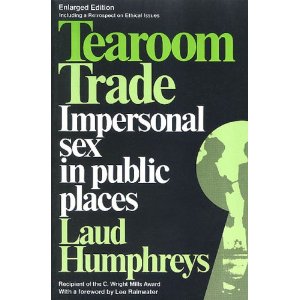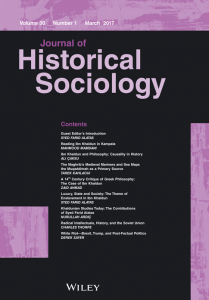Laud Humphreys' Tearoom Trade: The Best and Worst of Sociology?
 In Tearoom Trade (1970/1975), Laud Humphreys’ writes about the homosexual relations that took place in various “tearooms” (i.e., public bathrooms) in an unidentified American city during the mid- to late 1960s. By pretending to be a simple voyeur, Humphreys explains that he systematically observed these activities and even recorded the license plate numbers of a sample of tearoom participants. While the systematic observation part of his study permitted an understanding of the rules and roles, patterns of collective action, and risks of the game associated with impersonal gay sex in public restrooms, his tracking down and interviewing a handful of the subjects allowed Humphreys to better understand the identity, lives, and rationality of those men involved in the so-called tearoom trade. While the author defended the ethics behind his research early on, he was still stunned by the backlash it received. Yet, even years after Humphreys’ death, the ethical issues that his study provoked continue to reverberate in the social research community. In response to such issues, I will use this post to critically evaluate the strong and weak points of his book.
In Tearoom Trade (1970/1975), Laud Humphreys’ writes about the homosexual relations that took place in various “tearooms” (i.e., public bathrooms) in an unidentified American city during the mid- to late 1960s. By pretending to be a simple voyeur, Humphreys explains that he systematically observed these activities and even recorded the license plate numbers of a sample of tearoom participants. While the systematic observation part of his study permitted an understanding of the rules and roles, patterns of collective action, and risks of the game associated with impersonal gay sex in public restrooms, his tracking down and interviewing a handful of the subjects allowed Humphreys to better understand the identity, lives, and rationality of those men involved in the so-called tearoom trade. While the author defended the ethics behind his research early on, he was still stunned by the backlash it received. Yet, even years after Humphreys’ death, the ethical issues that his study provoked continue to reverberate in the social research community. In response to such issues, I will use this post to critically evaluate the strong and weak points of his book.
In regards to the strong points of Humphreys’ study, there were certainly many. Firstly, I really liked what the author had to say about some tearoom participants wearing “a breastplate of righteousness.” It makes sense that men engaging in impersonal gay sex, especially those with much to lose, would want to appear conservative so as to hide their deviant dalliances from others. This idea—that “there is a witch behind every witch hunt”—continues to have resonance today (Humphreys 1970/1975:141). Secondly, I found it interesting that Humphreys classified the participants by occupational status and marital status: trade, ambisexuals, gay, and closet queens. I further found it intriguing for Humphreys to suggest that closet queens may be the most dangerous of the groups to society because of their attraction toward youth and because of their relative unattractiveness to adults. Thirdly, I liked that Humphreys wrote about the importance of blackmail, especially when it comes to the police. The idea that those with power and resources can trade money for silence highlights the inequality and corruption that still exist in our criminal justice system. Lastly, I think it is important that Humphreys’ study continues to highlight ethical problems. Among others, Babbie (2004) writes about how this study has pushed researchers to constantly hold themselves responsible for the well-being of their subjects.
Still, while I liked this book, I did have a few problems with it. Firstly, I took objection to the tracking of the tearoom participants. Although Humphreys would later write that he regretted this decision and that he should have only interviewed willing subjects like the twelve informants he referred to as the “intensive dozen,” the use of deception to find and interview the respondents was somewhat appalling. Secondly, Humphreys contends that Americans are squeamish about things like tearoom sex because sex that is tolerated privately is not tolerated publically—that is, people in the U.S. don’t like the idea that public sex may put bystanders in an uncomfortable and unrequested position. But, if consent is the main issue, then why do we continue to have a large segment of the population actively championing laws designed to limit gay sex between consenting adults? Maybe Humphreys’ argument would have been stronger had he tied the breastplate of righteousness to the reasoning as to why many Americans want to control homosexual activity. Thirdly, I am not sure if I agree with Humphreys that the tearooms of today are like the bordellos of the past. Will all sexually rapacious men who would have gone to bordellos 100 years ago suddenly be OK with sex with other men? Lastly (and relatedly), I wonder about the possible bias Humphreys may have had towards his study considering that he would later come out as a gay man. Putting the assertions aside that he may have been sexually active in the tearooms (Babbie 2004), I am curious about how much (if any) of his writing was influenced by his own sexual preferences.
In conclusion, Humphreys’ study provides the reader with a discussion on an interesting (and surprisingly common) topic that had previously been virtually ignored. While there is certainly valid criticism of this work, I feel it has more strong points than weak ones. Still, this is just a cursory evaluation of his work, and I’m sure that there are many different opinions on the positive and negative aspects of Tearoom Trade. In your opinion, what are the best parts and worst parts of the work? Should Humphreys have done this study/written the book? Was it worth it/necessary? What do you think?
For Further Reading:




1467-7660/asset/DECH_right.gif?v=1&s=a8dee74c7ae152de95ab4f33ecaa1a00526b2bd2)
1754-9469/asset/society_affiliation_image.gif?v=1&s=9197a1a6ba8c381665ecbf311eae8aca348fe8aa)
The serendipity of your post is incredible in that this week’s reading for my SOC 1 students is an article on Humphrys’ Tea Room study. The focus is on research ethics, and later of course there will be Milgram and Zimbardo’s more famous experiments.
But I very much appreciate your critique of the positive elements of the study. And the magnitude of the backlash he received perhaps deserves its own study.
The fact is that I don’t know exactly how I even got to this page without backtracking a bit. But I just had to leave a not.
Best,
Eric Strayer
Hi Eric,
Thank you for your comment. Humphreys’ study certainly is a good example of questionable research ethics. I agree that the polarization it created would make for a good study.
Also, I’m glad that you had your students read about Humphreys’ work. He is an interesting character that is still able to grab attention today. I doubt that he had any idea that people would still be talking about his research so many years later. Whether he should have done the study or not, it is clear that he was uniquely successful at capturing an audience.
Thanks for the reply. It is a big internet. And now a bigger world (for many of us) for it. Nice to make a real connection once in a while.
best,
es
Humphreys was invited to speak at The Maxwell School of Syracuse University because the Sociology department was housed in that building. Humphreys revealed to the audience of students and faculty the location of a T-room in that building. He pin-pointed it and described what went on there. Needless to say, this made the use of that location impossible for homosexual men from the community. It was the refuge of profs, grad students, public school teachers, and even alumni—during home coming week! Humphreys destroyed the anonymity of the location which shut it down for many years. It was briefly active much later until the building was rebuilt during which rebuilding that men’s room was destroyed.
I was doing grad work at SU when Humphrey’s came to speak. Revealing a men’s room used in the building in which he was speaking echoed throughout the University and the city. As Jay Pearson says, it was indeed the talk of the town and, as I understand it, wrecked the use of that facility for the many different men who had used it. This seems to me to be an unethical decision by a researcher. Aren’t such researchers supposed to leave their subjects or situations unharmed by the research they do? Therefore, I suspect that he was a deeply self-hating gay man and a mean-spirited one with no empathy at all for his subjects. You would do better to read the books of Boyd McDonald. He harmed no one, and published in detail, the writings of functioning homosexuals of every stripe. Humphreys was a jerk blood sucking men who either didn’t know what he was doing nor how untrustworthy he was.
Yes, Jay Pearson, I was studying at Syracuse University at the time. His reveal of the T-Room in the building where he was lecturing caused quite a stir on campus and in the city. As I see it, he gained access to this area of life and then betrayed the people who helped him to function there. He took away their “hiding place”, and for what reason? To gain notoriety that would enable him to get more speaking invites and earn more money! This was dishonest and unethical. Though he was in a straight marriage he eventually came out as a gay man. I believe he had lived as a self-hating person for so long that he hated on the men from whom he had gained so much. In other word, he was a mess and probably caused a lot of damage and distress to the people he was studying. Those who left Washington University because of this man’s behavior were completely right in doing so. Humphrey was a mess and made a mess. Now, the chance to create an ethical, honest study on same sex behavior has passed. Better information can be gotten from the books of Boyd McDonald.
Hello,
Is there anywhere that I can find a written article on his appearance at Syracuse ?
Thank you
LM
is this a micro or macro approach?